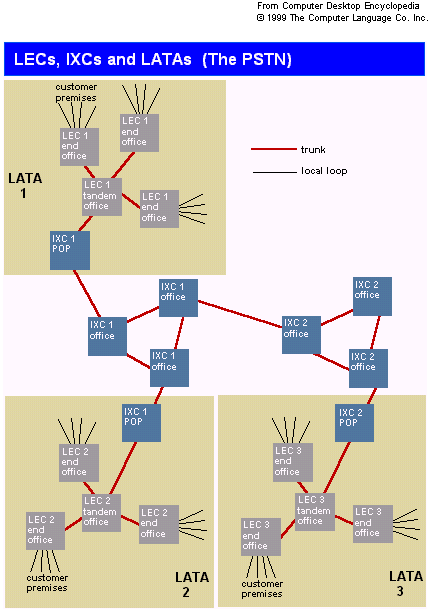Central Office
Tandem Office
A telephone switching center (central office) that does not connect directly to the customer. It connects offices in the same network or between networks, but always deals with trunks rather than customer lines. After Divestiture, most Class 4 tandem offices moved to AT&T, while Class 5 local tandem offices stayed with the RBOCs where they remain today. RBOCs installed new tandem offices to handle intraLATA toll and provide access to the interLATA toll carriers. Tandem offices and end offices are generally located in the same facility, and may even be serviced by the same switch.

Tandem Offices and End Offices
The PSTN is made up of local exchange carriers (LECs) and interexchange carriers (IXCs) that are governed by LATA boundaries. Note that a tandem office carries traffic between end offices and does not link to the customers themselves. Also note that IXC 2 does not have POPs in LATAs 1 and 2 and must have a reselling agreement with IXC 1 in order to gain access to those areas.
Dial-Up vs Dedicated vs Roaming

It is not as common anymore, but in the not too distant past, many people used a dial-up connection to access the Internet or their place of work, using a computer modem. Which isn't quite as bad as having to use tin cans for phones - but close. Pause and think about the fact that right now there is a whole generation of humans being born who will never know the headaches of having to use a dial-up connection to access the Internet.
The type of connection you have is not always an economical choice. At present, the first question that needs to be answered is "what service is available in my area?" Then you ask "how much does it cost," and "can I afford it?" You can find answers to these questions by calling your local service provider(s) - which you may have to do if you don't already have an Internet connection available. But, then, I have to ask, how are you reading this screen? If you do have access to the Internet then it is quite easy to search and find what services are available in your area and how much it will cost.
Dial-Up & the Central Office
Dial-up remains problematic and is slowly, but surely, being replaced with higher speed, "always on," dedicated connections. If the phone or cable company is digging up the streets in your neighborhood, more than likely, they are installing fiber cabling that reaches from their nearest switching facility (called a Central Office or CO) to your neighborhood. The limiting factor that has always been the bottleneck for even more households getting high-speed Internet has been that the phone lines were all made of copper, just like an American penny. Ma Bell and others have been stringing copper wire from one CO to the next, and from each CO to each household, for over a century. That's a lot of copper. Problem is, the farther your node is from the CO, the worse the quality of the single on the wire is. With voice you hardly ever notice a problem, but with high speed data the fact that the signal "attenuates" the farther it travels means a lessor amount of data can be reliably transmitted back and forth.
Mobile with WiFi
Roaming is a fairly new phenomenon and like anything having to do with electronics there are competing standards. WiFi came first and continues to be popular with open networks being provided by city and other government agencies. Many university and college campuses offer their students and employees free WiFi access to the
Internet as well. WiFi refers to the IEEE 802.11 standard for wireless data communications. Almost all computing devices created after 2014, laptops, handhelds, Pocket PCs, Tablet PCs, and pretty much all models, have built-in support for 802.11 wireless technology. So currently you'll find that many coffee shops, bookstores, shopping malls, city plazas, and the like, are providing WiFi "hot spots" for accessing the Internet. People taking advantage of these hot spots are considered to be "Mobile" users, gaining access to the Internet wherever a hot spot is accessible. The downside is that there are wireless hackers out there looking for accessible hot spots as well, including at YOUR house - it's called "war games" driving. War games driving is where someone cruises around in their car from neighborhood to neighborhood looking for unsecured wireless access points. So that wireless connection you are using to view this Web page with, if it's not secured, could be being shared with somebody parked out in front of your house right now.
Roaming with Cellular
Then along came the cellular phone companies, who began offering Internet access through their communications networks. And, many of the big ones, like Verizon, opted to implement the EVOC wireless technology instead of 802.11. So while most of us consumers, who have already invested in wireless technology, all use devices based on 802.11, we now need to add-on another transceiver that is EVOC compatible if we want the Internet via our cell phone providers' network. Cellular companies can offer their customers the ability to roam from one location to another without losing their connection to the Internet, as long as they don't lose cell service - so these users are "roaming" users of the Internet.